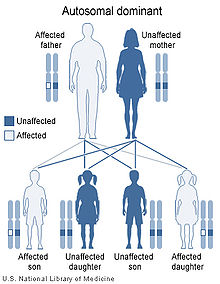- Branchio-oto-renal syndrome
-
Branchio-oto-renal syndrome Classification and external resources OMIM 113650 DiseasesDB 32599 MeSH D019280 Branchio-oto-renal syndrome (BOR), also known as branciootorenal syndrome or BOR syndrome, is an autosomal dominant genetic disorder involving the kidneys, ears, and neck. It has also been described as Melnick-Fraser syndrome[1] after Frank Clarke Fraser and Michael Melnick.[2]
Contents
Presentation
Individiduals with BOR may have underdeveloped (hypoplastic) or absent kidneys with resultant renal insufficiency or renal failure.
Ear anomalies include extra openings in front of the ears (preauricular pits), extra pieces of skin in front of the ears (preauricular tags), or further malformation or absence of the outer ear (pinna). Malformation or absence of the middle ear is also possible. Individuals can have mild to profound hearing loss, which can either be sensorineural, conductive, or mixed. People with BOR may also have cysts or fistulae along the sides of their neck corresponding to the location of the embryologic branchial clefts.
Genetics
BOR is inherited in an autosomal dominant manner, and results from a mutation in the EYA1 gene.[3][4] Autosomal dominant inheritance indicates that the defective gene responsible for a disorder is located on an autosome, and only one copy of the gene is sufficient to cause the disorder, when inherited from a parent who has the disorder.
See also
- Lachiewicz Sibley syndrome
References
- ^ Wang Y, Treat K, Schroer RJ, O'Brien JE, Stevenson RE, Schwartz CE (June 1994). "Localization of branchio-oto-renal (BOR) syndrome to a 3 Mb region of chromosome 8q". Am. J. Med. Genet. 51 (2): 169–75. doi:10.1002/ajmg.1320510221. PMID 8092198.
- ^ Melnick-Fraser syndrome I at Who Named It?
- ^ Online 'Mendelian Inheritance in Man' (OMIM) Branchiootorenal Syndrome 1; BOR1 -113650
- ^ Branchiootorenal syndrome from Gene Reviews
Congenital abnormality · multiple abnormalities (Q87, 759.7) Craniofacial Short stature 1q21.1 deletion syndrome · Aarskog–Scott syndrome · Cockayne syndrome · Cornelia de Lange Syndrome · Dubowitz syndrome · Noonan syndrome · Robinow syndrome · Silver–Russell syndrome · Seckel syndrome · Smith-Lemli-Opitz syndrome-Turner syndromeLimbs Overgrowth Laurence-Moon-Bardet-Biedl Bardet–Biedl syndrome · Laurence-Moon syndromeCombined/other,
known locus3 (Zimmerman-Laband syndrome) · 4/13 (Fraser syndrome) · 8 (Branchio-oto-renal syndrome) · 12 (Keutel syndrome, Timothy syndrome) · 15 (Marfan syndrome) · 19 (Donohue syndrome)Categories:- Nephrology
- Syndromes
- Autosomal dominant disorders
- Genetic disorder stubs
Wikimedia Foundation. 2010.

